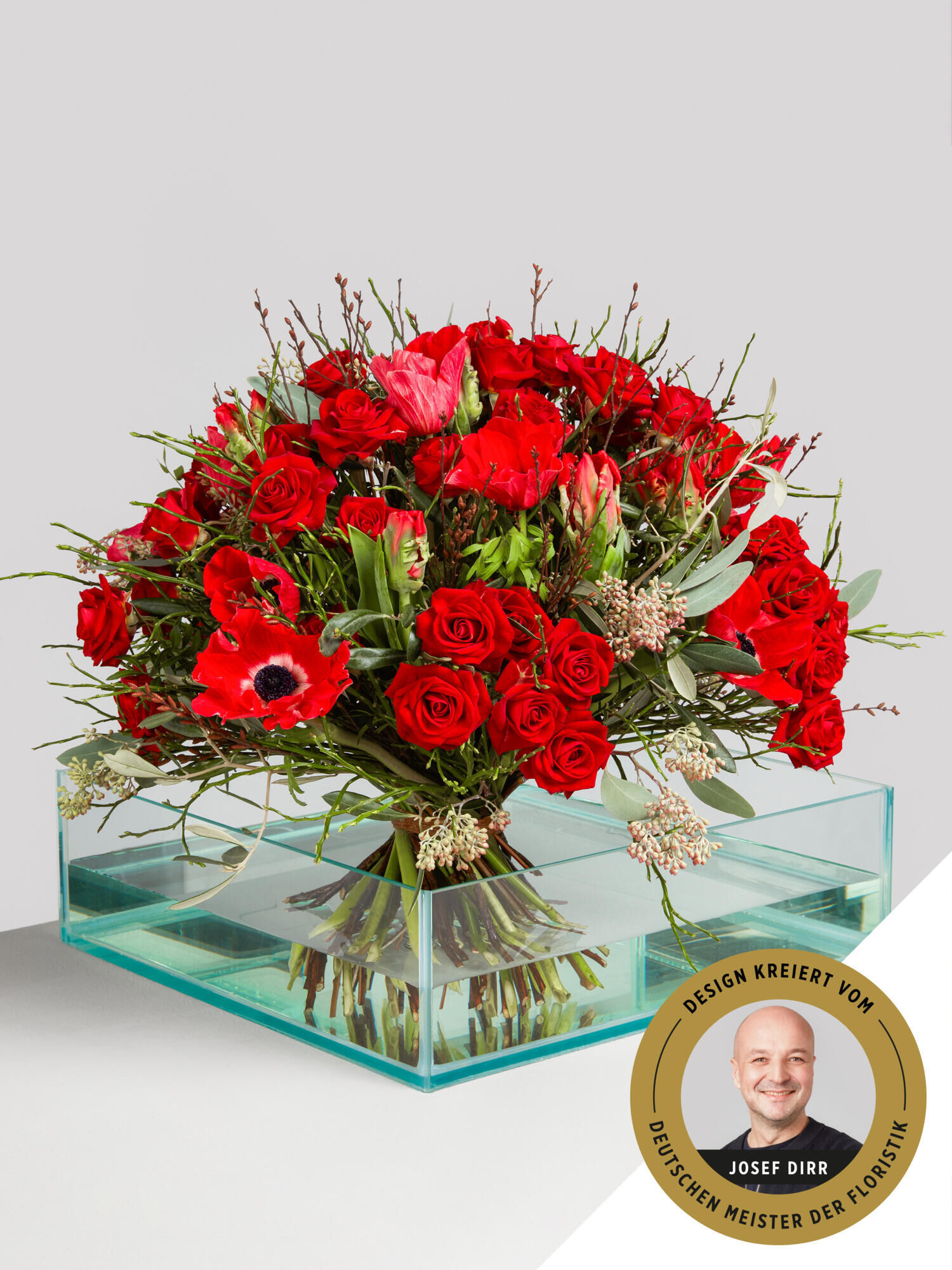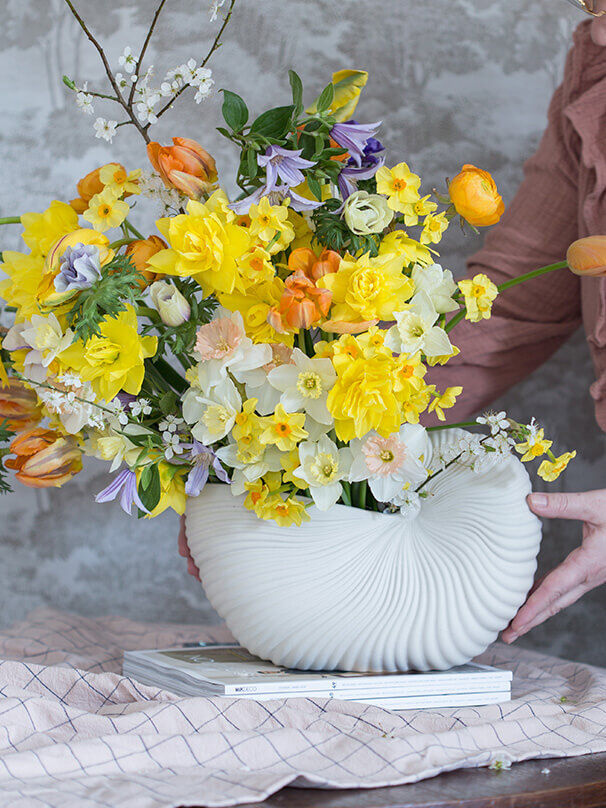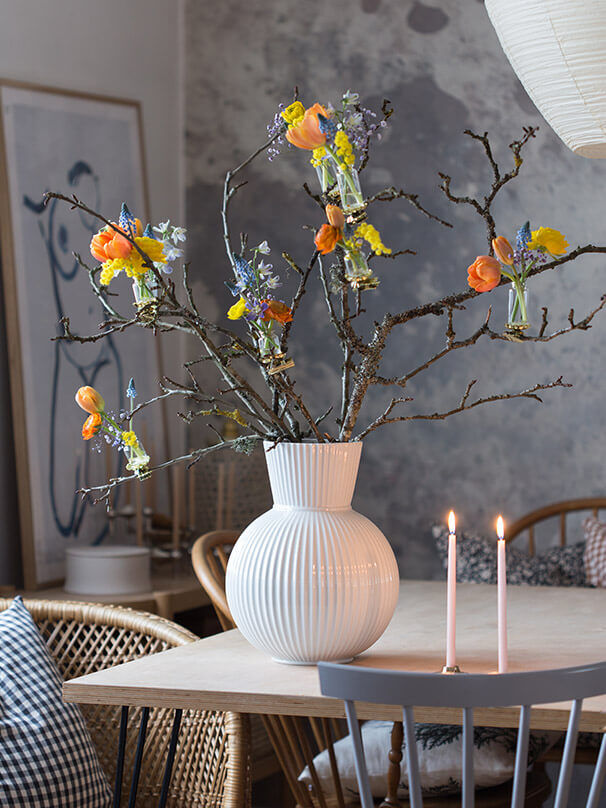Tulips

Despite the low temperatures, tulips bring the first long-awaited feelings of spring into our homes as early as January! After the dreary weather of winter, we all enjoy the different bright and vibrant colours that tulips bring with them with ease. That's why cut flowers and especially tulips in a vase are the perfect spring decoration for your own four walls and should definitely not be missed!
The origin and significance of tulips
They are among the first harbingers of the year, delighting us with their fresh, colourful flowers. Even though the largest and most varied bulbous flower genus is primarily associated with the Netherlands, it originally comes from the high mountain ranges of Central Asia. The climate there offers ideal conditions for the bulbous flowers, which like the sun but do not like heat or too much humidity.
In the 16th century, the first tulip bulbs arrived in the Netherlands via Turkey and Austria, where a highly speculative trade quickly began. Varieties with feathered or mottled flowers in contrasting colours ensured that in the 1630s a single tulip bulb could pay for a large canal house in Amsterdam. However, this world's first speculative bubble burst at the beginning of February 1637, after which the Dutch made a name for themselves throughout Europe as growers and suppliers of tulips - and have maintained this reputation to this day.
What types of tulips are there?
Tulips are a genus of plants belonging to the lily family (Liliaceae). There are over 150 species and an estimated 5,000 different varieties of this popular bulbous flowering plant worldwide. The most important distinguishing features are the flowering time, growth height, flower shape and flower colour. If you like extravagant flowers, you can choose colourful parrot tulips with wavy or fringed petals, for example, which look like feathers.
In the garden, they belong to the late-flowering varieties. French tulips, whose stems, as with all tulips, continue to grow in the vase and can reach a length of up to 90 centimetres, look elegant. They are considered to be particularly long-lasting, but are also somewhat more expensive than other species. Lily-like tulips are also very visually appealing: their petals are pointed and open in a star shape.
Appearance and flowering time
The first tulips start to grow in our gardens in March. These are usually smaller, but very brightly coloured wild species. The main flowering period is officially in April. Species with double or large flowers usually take a few weeks longer to fully develop - some don't even flower until May or early June.
If you forgot to plant tulip bulbs last autumn, you can still easily buy them in March as pre-grown plants in specialist shops and cultivate them in the garden. The bulbs thrive best in a full sun location in well-drained, not too moist soil.
The planting holes must be at least twice as deep as the height of the bulbs so that the tulips have a firm hold even in strong winds and can develop well. If the soil is clayey, the planting holes can be loosened with coarse sand. Frost protection made from bark mulch or leaves won't hurt either. To prevent the bulbs from being eaten by voles, it is best to place them in the holes with close-meshed wire baskets.
Tulips reach the peak of their bloom in mid-April. The tulip season usually lasts from the end of March to mid-May. Sometimes even until the beginning of June.
That depends on the species and variety. But when the temperatures here reach double figures, the tulips start to flower. It takes around four to six weeks for the full bloom to appear. However, soil conditions, watering and rainfall, location and the quality of the bulb play a decisive role in flowering.
Location and the right soil for tulips
The bulbs thrive best in a full sun location in well-drained, not too moist soil.
After flowering, give your tulips enough time to "retire" in peace. Above all, do not cut back the leaves and stems prematurely. In autumn, organic fertilisers such as horn shavings are suitable. In spring, when the tulips sprout again, their growth can be supported with a mineral fertiliser. Experts advise using compost sparingly, as flower bulbs do not like humus-rich soil. Fertilisation is particularly important to ensure that the tulips do not lose their flowering splendour even years later. However, this is only successful if you are dealing with long-lasting species and varieties, such as botanical varieties and wild tulips, Darwin or Viridiflora tulips, and not parrot tulips, which usually "disappear" after one season.
The ideal location for tulips is in a sunny to semi-shady position in a slightly humusy to sandy soil. Permeability is important. Waterlogging should be avoided to prevent the bulbs from rotting.
Care tips for tulips
The biggest enemies of tulips are voles. Planting baskets can prevent damage caused by mice. The leaves of the tulip are a favourite with snails. In suitable soil and good locations, rot pathogens have little chance.
The ideal time to plant tulip bulbs is in autumn - from September until the frost. If you find bulbs that you have forgotten to plant, you don't need to throw them away. Take a bowl or tub and plant them in there. Overwinter them frost-free. These tulips are also guaranteed to sprout in spring, perhaps with a slight delay.
As a rule of thumb, the bulb should be planted at least twice as deep as its circumference.
Bulbs are both annuals and perennials. How does that fit together? Bulb flowers reproduce via daughter bulbs, as do tulips. A bulb is only ever an annual, as it dies after one year. In the best case scenario, however, it forms daughter bulbs beforehand, which then delight us with new flowers in the next season and later also form daughter bulbs.
Once the tulips have faded, the flowers should be cut off to prevent seeds from forming. The plant has to expend unnecessary energy to form seeds, which would be better stored in the bulb instead. The leaves should only be cut off when they have completely withered and all the nutrients have been transported from the leaves to the bulb and stored there.
Each tulip bulb only develops leaves and flowers once in a season. When the bulb flower has faded, seed capsules appear and daughter bulbs form on the bulb. The flowers should be cut off so that they can store a lot of energy. However, the leaves should remain on the stem until they wither and have thus transported all the energy into the bulb. To ensure that tulips continue to flower profusely in the second and third year, tulip bulbs should be replanted every year, as the daughter bulbs that form from the previous year's bulbs usually do not develop as profusely. If you choose botanical tulip bulbs, you'll get a robust bunch of colourful flowers that will also grow wild over the years.
In locations where it gets too damp in summer, or with favourite varieties, it may be advisable to dig up the bulbs after they have dried out and "over-summer" them in an airy, dry and cool place. Wooden boxes with loose humus soil are suitable for this, or the bulbs can be hung up in bundles. They can then be freshly planted again from September.
Proper care for tulips in the vase
One of the most important care tips is to cut the bulbs correctly and place them in water that is not too deep. If you then place your bouquet of tulips in the vase on their own - without combining them with daffodils - and keep them in a cool place overnight, you will be able to enjoy your tulips for a long time.
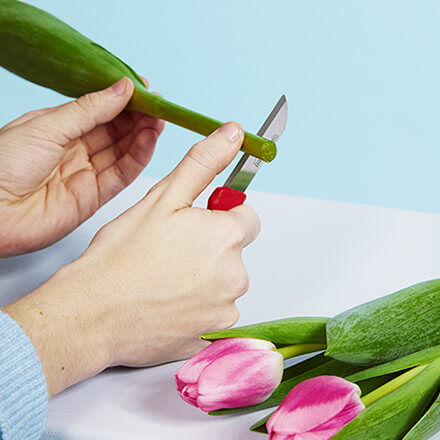
Cutting tulips correctly
Firstly, the same applies to all cut flowers: cut the stems with a sharp knife. But why should you cut tulips straight and not at an angle? Tulip stems have a special feature: they are cut straight so that the tulips do not absorb too much water in the vase. This prevents them from growing too much. Ideally, repeat this every 2-3 days and cut off any brown stem ends. This prevents rotting and improves nutrient uptake.
Important: Please use a sharp knife for cutting and not scissors, as these can bruise the delicate tulip stems so that both water and nutrients cannot be properly absorbed.
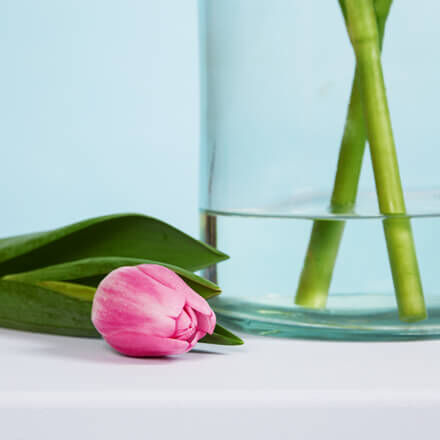
The right water for tulips
Place your tulips in a clean vase with fresh, cool water. If the vase has not been thoroughly cleaned and is still slightly dirty, this is the perfect habitat for bacteria and the tulips will wilt more quickly. The cool water also prolongs the life of the tulips and keeps them fresh, whereas warm water is more likely to soften the crisp stems. It is best to fill the vase with only a little water (2-3 cm) and remove the lower leaves, otherwise the beautiful tulips could start to rot.
But be careful: tulips are thirsty. So check regularly whether there is still enough water in the vase and ideally change it completely once every other day.
TIP: A splash of lemon juice in the flower water extends the shelf life of your tulips - without any chemical additives! Why is that? Citric acid has an antibacterial effect, preventing bacteria from forming and rotting the tulip stems. The citric acid lowers the pH value and the vitamin C it contains has a preservative effect.

The right vase for tulips
When caring for tulips, you also need to choose the right vase shape: As tulips are known to grow strongly, tall and narrow vases are particularly suitable. This supports the stems.
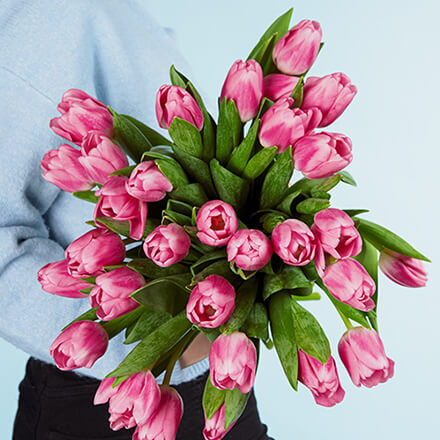
The right location for tulips
Tulips prefer a cool location without draughts and direct sunlight.
If the temperatures are too warm, the tulips will shoot up, which shortens their shelf life. To make the tulips last even longer, it is best to place them in a cool room at night or outside. However, make sure that your tulip bouquet is protected from frost.
Cut the stems straight again, then wrap the tulips tightly in newspaper and place them in fresh water for about an hour. They should then have caught and straightened up again.
If you have the opportunity to place the vase in a cool place at night (caution: no frost!), you can prolong the vase life of your tulip bouquet. Tulips are also real divas when it comes to their partners. They prefer to be in the limelight themselves. A vase partnership with daffodils should be avoided at all costs. Their stems secrete a slime that can clog the stems of the tulips.
Mistakes in tulip care
A copper coin in the flower water is supposed to prolong the life of the tulips, as copper has an antibacterial effect and kills fungi. So this is actually not a mistake. However, there is a catch: it takes some time for copper to develop its effect. During the short "lifespan" of the tulips, coins cannot release enough copper to prevent the formation of bacteria and kill fungi. As a result, they unfortunately do not have a positive effect on the shelf life of your tulips. So it's better to save your money and feed your piggy bank with your pennies.
Another common tip is to add a little sugar to the vase water to prolong the life of cut flowers. It is said that sugar provides nutrients for flowers and that even the preservative in specialised shops contains sugar. But there is a catch here too: sugar is the perfect breeding ground for bacteria, which can cause cut flowers to wilt quickly. Sugar can therefore shorten rather than extend the shelf life of tulips. For this reason, the preservatives in specialised shops also contain antibacterial substances.
Our recommendation is therefore to use a well-cleaned vase and add preservative to the fresh water. This will reliably extend the shelf life of your tulips!
Aspirin in flower water keeps cut flowers fresh for longer? As you can probably already guess, that's not quite true!
One component of aspirin is acetylsalicylic acid, better known as willow acid, which can also be found in small quantities in various plant species. This is said to have a protective function and counteract the formation of bacteria. The ingredients of aspirin are also said to lower the pH value of the flower water. This should also lead to less bacteria developing and the flowers lasting longer. So adding a little aspirin to the flower water doesn't sound so bad after all.
However, the dosage is a problem: too much aspirin can actually have the opposite effect and the tulips wilt more quickly, so the rule here is "less is more".
The last tip is also the one most discussed among flower experts. Does it prolong the life of tulips if you prick the stem just below the flower with a needle? Some are in favour of this tip and justify its effectiveness by saying that it prevents the tulips from growing, which should lead to a longer shelf life. Critics point out that bacteria can penetrate the stem of the tulip in this way, which leads to the flowers rotting and wilting more quickly. So this tip cannot be clearly proven to be a mistake!
















